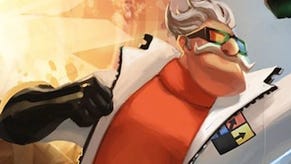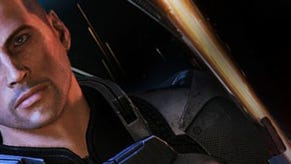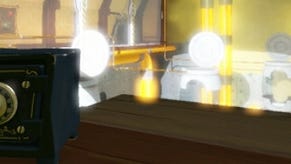No Portals, No Problem: Swift on Quantum Conundrum
Kim Swift, one of the minds behind the original Portal, has apparently made a game so funny it causes physical pain. Nathan Grayson suffers for his art.
After witnessing a 20-minute demo of Quantum Conundrum, I left a tiny hotel conference room in a state of physical pain. My head throbbed. My ribs ached. “Man,” I thought to myself, “that was easily the best thing I've seen in ages.”
No, former Portal lead Kim Swift didn't ambush me with some makeshift weapon-of-largely-cosmetic-destruction and beat me until I promised to say good things about her game. My head, you see, felt like it'd imploded because Quantum Conundrum's dimension-shifting puzzles tied my brain in knots. And my ribs? Well, even my incredibly manly form can only do so much when exposed to 20 grueling minutes of no-holds-barred childlike laughter.
The comparison's inevitable, so I may as well get it out of the way: Quantum Conundrum reminded me of the first time I played Portal. And I mean the very first time. It was like picking up an entirely foreign language and simultaneously achieving fluency in the same day. But, you know, with more men in giant bunny costumes.
So here's the gist: You play as a young boy who's been dropped off at his uncle's manor for a nice day of presumably typical, non-reality-bending bonding. That, however, all goes out the window when it turns out that your uncle's sort of a mad scientist. And by “sort of,” I mean “He's cloned his cat, like, a million times.” He's also mysteriously gone missing, which shouldn't be too surprising given that mad science is only among the world's safest professions when you're the one causing the apocalypse. Conveniently, though, he's left his inter-dimensional shift device lying out in the open. That, says Swift, is the starting point for the game's uniquely delightful vibe.
“There aren't a whole lot of games where you're a kid,” she told VG247 during a post-demo interview. “We wanted the mansion to feel kind of overwhelming. You come into this situation and go 'Oh my god, everything is so big.' We want it to feel imposing, but we also want you to feel empowered, because you have the ability to manipulate this big, imposing environment how ever you want. So we thought it was a really good juxtaposition of intimidating environment and power.”
All fun, some fluff
The device, of course, is Quantum Conundrum's central puzzle-solving tool. In a nutshell, it allows you to bounce between dimensions on the fly, resulting in room-by-room puzzle-solving that runs the gamut from rapid-fire to slow-and-steady to both at the same time. And that'd be interesting enough if these were “normal” alternate worlds, but well, these aren't your father's dimensions – unless he also happens to be somebody's cartoon mad scientist brother.
First up, I was shown the Fluffy Dimension. At the press of a button, the manor's entrance – once brightly colored and immaculately wood-paneled – turned to shaggy white fur. Every single surface. Hell, even a nearby portrait of the main character's uncle donned a correspondingly colored bunny suit. Hilarious as it is, though, the Fluffy Dimension's not just around for a quick laugh. All objects within its lovably, hugably soft grip become immeasurably lighter, allowing the main character's tiny child arms to lift and even fling them as you see fit.
For instance, the demo's presenter – lead environment artist Matt Salladay – needed to get a safe past a thick glass wall. But how? Given that there was no actual elephant in the room, his best bet ended up being the elephant in the room: the shift device. So he switched to Fluffy, tossed the safe into the air, and then flipped back to normal, sending the once again back-breakingly heavy safe crashing through the glass. That, however, is just the tip of the iceberg.
Next up, Swift and Salladay introduced the Slow-Mo Dimension, which they used to temporarily bring down a laser-based security system. By dropping a box coughed up by DOLLI – a cloning system represented by a giant robot face located in different locations throughout the manor – and slowing time, they were able to block the main laser long enough to sprint right past its grid without a single hair singed or face horrifically maimed. And all the while, the world took on a sepia-toned lens filter and nearby portraits impatiently glared at their pocket watches. Even a pet goldfish. Even a pet goldfish.
And then there's the Reverse Gravity Dimension, which – at least, in the demo I saw – tied everything together. First up, Swift and Salladay moved it with Fluffy, reversed gravity, and hopped on top to create a makeshift elevator. Simple enough, right? Later, though, they hurled a Fluffy safe across cavernous gap, immediately switched into Slow-Mo, hopped on, and then alternated between regular and reversed gravity to keep the multi-ton hunk of metal bobbing gracefully through the air. Other games have allowed us to explore everything from the furthest reaches of space to the darkest corners of our own minds, but have they allowed us to safe-surf? Didn't think so.
Now then, consider the possibilities with just those three dimensions in your arsenal. That crackling sound? That scent that's made up of one part bacon and one part your most malignant psychoses? That's your brain short-circuiting. And now, here's the kicker: there's a fourth, still-unannounced dimension.
“We're demoing [the game], and we want people to get it,” Salladay said. “So there's a lot of depth we're not showing – some of the more complex things you can do. There's a lot of really fun things you can do messing around with each of the dimensions. Once you really learn how to manipulate Reverse Gravity and Slow-Mo, the possibilities are endless.”
Endless possibilities
But really, what does that even mean? After all, you can only add so many layers of complexity to a puzzle before it becomes nothing more than a glorified funhouse. Sure, the smoke-and-mirrors in games like Portal 2 are impressive, but it's only a matter of time before you see the man behind the curtain gently nudging you in the right direction. Even with tons of tools at your disposal, there's generally only one solution.
The original Portal, though, was highly lauded for cleverly catapulting itself over that pitfall. Happily, Quantum Conundrum looks to follow in its footsteps.
“By the fact that we have all these dimensions and they're interacting physically with the environment, there's different ways to solve everything in your particular style. I mean, even down to small things like the way [Matt] throws the box and then jumps on a higher object to get on top of it. My style is actually to throw it a bit below line-of-sight and then get a running start and jump straight onto it. So even down to little tiny things like that, it's play-as-you-want,” Swift explained.
"There's a lot of depth we're not showing – some of the more complex things you can do. There's a lot of really fun things you can do messing around with each of the dimensions. Once you really learn how to manipulate Reverse Gravity and Slow-Mo, the possibilities are endless."
“We also have quite a few puzzles where there are maybe two or three solutions. We didn't actually think of a lot of them [laughs]. But we watched people solve them, and we were like 'No, no, that's legit. You're clearly understanding what the dimension is, and you solved the puzzle.' To us, that's like 'Yep, good job!' As long as you're not bypassing something that we're deliberately trying to teach you, then it's cool. Works for us.”
The walls have mismatched eyes
Puzzles – ingenious though they may be – are hardly all Quantum Conundrum's got going for it. Jostling for position at the top of the list is a delightfully dark sense of humor that's exemplified by a single, ordinary cat... who then became other cats. Who then became other, other cats.
“So it actually started with the derpy cat first,” said Swift. “I was like 'I think the professor should have a cat named Widget.' And our artist was like 'What do you want him to look like?' And I was like 'I don't care. Like a cat!' So he goes looking online like 'I need to find the ugliest cat possible.' Eventually, he found a picture of one of those flat-faced Persian cats, and he was like 'God, they look so awful.'"
“I know cats exist that look like that, but it really just doesn't look right – kind of like it went through the cloning machine a couple of times. It didn't come out quite as it should be, because – every once in a while – DOLLI messes up and creates an object that's... not right. So I'm like 'Wouldn't it be funny if that's actually the byproduct of a couple clonings of this cat?' So we reverse engineered the cat and came up with the first cat with the monocle. The first cat was a brilliant genius, and the third generation cat is just not quite right in the brain.”
Sure enough, a hallway full of portraits tells the sad tale of Widget's fall from lofty genetic heights. First painting: a monocle, top hat, and heaping helpings of poise. Second: wide, glassy eyes and a bewildered expression. Third: the most stupidly adorable, stupidly hilarious, and downright stupid thing you'll ever see. It's also interesting, though, because these portraits – not NPCs or some GlaDOS-like omniscient presence – were the demo's main means of storytelling. From what I saw, it fit the game's tone incredibly well, too. For Swift and Salladay, that's mission accomplished.
“Our concept artist makes really pretty pictures, and we were like 'Hey Chris, could you make some pretty pictures?' And he was like 'OK!' And then we thought it'd be a really fun gag that each picture has its own particular look in each dimension. We showed one set of pictures to a small audience within in the company, and everyone was laughing their butts off. So we were like 'OK, we're going to keep doing that!'” Swift explained.
“We got to do a really fun kind of jam where everybody – programmers, designers, whoever – got to throw their ideas up on the board,” Salladay added. “And one of the things we always came back to is that we wanted to do something slightly cartoony with a lot of color and a lot of character. Since you're going to be there for four-to-six hours, we wanted the house to be fun and cool to look at. We went with this because it's quirky and fun. It really just fits the game.”
Thinking without portals
Walking away from a demo without some stomach-churning concern – nitpicky or not – isn't something I typically do. It's good, after all, to ask questions. Here, though, I feel shockingly comfortable getting stupidly excited. What I saw of Quantum Conundrum looked fantastic – plain and simple. Is its Portal lineage a bit too obvious at times? Sure. But when something looks to be this much fun from top-to-bottom, it's hard to get caught up in the little things. It's not surprising, then, to hear Swift say things like this:
“We had a lot of fun creating this project. We worked really collaboratively as a team, so it's not just me going 'Do this thing! Do that thing!' We all vote on what we want to do in any sort of major decision we make in the game – even down to, like, level design. We determine a goal – for instance, 'Hey, we need to teach Fluffy Dimension. Let's come up with a couple puzzles to do that.' ...I believe games should be fun, and the easiest way to catch fun is to make it and play it and see if it's any good.”
My ribs still sting a little. That should tell you about all you need to know.
Quantum Conundrum releases on Steam, XBLA and PSN in 2012.








